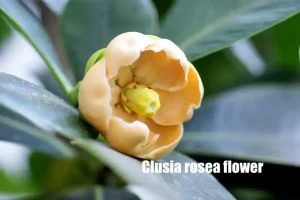
Clusia Rosea, commonly known as the autograph tree, is a unique and low-maintenance houseplant that has gained popularity among indoor gardeners and is easy to care for. Its glossy, dark green leaves and white flowers make it a perfect addition to any indoor space. If you are looking for a resilient and visually appealing plant to grow indoors, Clusia Rosea might be your ideal choice. Just read through our article to help you get the smart garden guide.
Introduction to Clusia Rosea
The Origin of Clusia Rosea
Clusia Rosea, also called the autograph tree, is an evergreen versatile plant that thrives indoors. It is known for its leathery, oval-shaped leaves and white flowers that add a touch of elegance to any space.
The Unique Features of the Autograph Tree
The autograph tree is characterized by its ability to grow aerial roots, making it a visually captivating addition to any indoor garden. Its resilience and ability to thrive in low-maintenance conditions make it popular for indoor plant enthusiasts.
Why Grow Clusia Rosea Indoors?
Growing Clusia Rosea indoors allows you to enjoy this unique plant’s beauty year-round without worrying about outdoor weather conditions or pests that might affect its growth. With the proper care, it can thrive in an indoor setting, bringing a touch of nature to your living space.
Growing conditions of Clusia Rosea
To grow an autograph tree, providing the right conditions, including adequate water, moderate humidity, indirect light, well-draining soil, and fertilizing, can help maintain its health and appearance. Understanding its specific care needs will help you create a suitable environment for the plant to thrive.
Light
Providing indirect light and going with a well-ventilated area is vital to maintaining the health and vigor of Clusia Rosea. Give your plant a place inside the house where it can receive not direct sunlight consistently, for example, a south-facing window.
Soil
Clusia Rosea will grow best when with well-draining but soggy soil. The soil is soft, loose, and potting mix soil, which can retain moisture well.
Fertilizing
Use a 5-10-10 blend or 10-10-10 fertilizer diluted and monthly fertilizing when the plant grows actively.
Watering
Providing the right amount of water is crucial for the health and vitality of Clusia Rosea. It is essential to understand the specific watering needs of this plant to prevent issues such as root rot and ensure optimal growth. Clusia Rosea prefers a moderately moist environment, so watering it when the top inch of the soil is dry is recommended. This typically translates to watering the plant once every 1-2 weeks, but the frequency may vary based on factors such as environmental conditions and the pot size. Ensuring proper drainage and avoiding overwatering is crucial for preventing root rot and keeping the plant healthy.
Precautions for Overwatering and Underwatering Clusia Rosea
Both overwatering and underwatering can have detrimental effects on the health of Clusia Rosea. Overwatering can lead to waterlogged soil and root rot, while underwatering can cause stress and impact the plant’s overall vigor. Monitoring the soil moisture and adjusting the watering frequency based on the plant’s needs is essential for maintaining a healthy balance and preventing water-related issues.
Humidity
While Clusia Rosea can tolerate lower humidity levels, it thrives in environments with moderate humidity. You can maintain suitable humidity levels by misting the plant occasionally or placing a tray of water near it to increase the moisture in the air. However, it is essential to avoid excessive moisture accumulation, which can create a breeding ground for pests and diseases.

Caring for Clusia Rosea
Clusia Rosea, the autograph tree, requires regular care to ensure optimal growth and health. Proper pruning and maintenance play a crucial role in nurturing this houseplant. You can enhance the plant’s visual appeal and overall vigor by maintaining its shape and size.
Pruning and Maintaining Clusia Rosea
Regular pruning is essential for maintaining the shape and health of Clusia Rosea. Use clean, sharp scissors to trim any dead or yellowing leaves and any crowded or overgrown branches. This not only enhances the plant’s appearance but also promotes new growth. Removing pests or diseased parts during pruning can help maintain the plant’s overall health.
Handling Pests and Diseases in Clusia Rosea
Pests and diseases can occasionally affect Clusia Rosea, but proper care and maintenance can help prevent and address these issues. Monitor the plant regularly for signs of pest infestation or disease, such as yellowing leaves, wilting, or unusual spots on the foliage. Treat any infestations promptly with suitable pest control measures to protect the plant’s health and appearance.
Dealing with Yellowing Leaves in Clusia Rosea
Yellowing leaves in Clusia Rosea can indicate various issues, including overwatering, inadequate light, or nutrient deficiencies. Address the root cause of the problem by adjusting watering practices, providing adequate sunlight, and ensuring proper fertilization. Removing yellowing leaves and promoting healthy growth conditions will help restore the plant’s vitality.
Repotting and Propagating Clusia Rosea
The Importance of Repotting Your Autograph Tree
Repotting Clusia Rosea is essential for maintaining its health and promoting optimal growth. Over time, the plant may outgrow its current pot, leading to root congestion and reduced vitality. Repotting allows for fresh, nutrient-rich soil, enhanced drainage, and adequate space for root expansion, supporting the plant’s overall well-being.
When and How to Repot Your Autograph Tree
Repotting your Clusia Rosea when it shows signs of root congestion, such as roots circling the pot’s bottom or emerging from the drainage holes, is recommended. This typically occurs every 2-3 years, allowing for the renewal of soil nutrients and prevention of root-bound conditions. Repot in a slightly larger container with adequate drainage to support the plant’s continued growth.
Methods for Propagating Clusia Rosea
Propagating Clusia Rosea can be achieved through various methods, such as stem cuttings or air layering. By propagating new plants from healthy, mature specimens, you can expand your collection of autograph trees and share their beauty with others. Carefully following the propagation process and providing suitable growing conditions will help ensure the success of new Clusia Rosea plants.
Conclusion
Understanding the specific care needs of Clusia Rosea is essential for successful growth and maintenance. By providing suitable Clusia rosea care, you can create an optimal environment for your autograph tree to thrive and adorn your indoor space with its elegant beauty.
Clusia Rosea adds aesthetic appeal to indoor spaces with its glossy leaves and white flowers and offers the benefit of being relatively low-maintenance and resilient. Embracing this plant’s unique beauty and benefits can bring joy and a touch of nature into your home, making it a valuable addition to your indoor garden.
